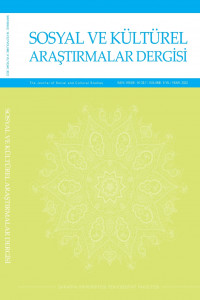Abstract
References
- Callender, C. & Cohen, J. (2016). There is No Special Problem About Scientific Representation. An International Journal for Theory, History and Foundations of Science 21/1(55), 67-85.
- Carnap, R. (1939). Foundations of Logic and Mathematics. O. Neurath, R. Carnap & C. Morris (Ed.), International Encyclopedia of Unified Science 1/3 içinde (ss.1-70). Chicago: The University of Chicago Press.
- Cartwright, N. (1983). How the Laws of Physics Lie. Oxford: Clarendon Press.
- Contessa, G. (2006). Scientific Models, Partial Structures and the New Received View of Theories. Studies in History and Philosophy of Science, 37, 370–377.
- Downes, S. M. (1992). The Importance of Models in Theorizing: A Deflationary Semantic View. PSA: Proceedings of the Biennial Meeting of the Philosophy of Science Association, 1, 142-153.
- French, S. & Vickers, P. (2011). Are There No Things That are Scientific Theories?. British Journal of Philosophy of Science, 62, 771-804.
- Frigg, R. (2002). Models and Representation: Why Structures are not Enough. Measurement in Physics and Economics Project Discussion Paper Series, DP MEAS 25/02. London: London School of Economics.
- Giere, R. N. (1988). Explaining Science: A Cognitive Approach. Chicago: The University of Chicago Press.
- Hempel, C. (1965). Aspects of Scientific Explanation and Other Essays in the Philosophy of Science. New York: The Free Press.
- Knuuttila, T. (2005). Models as Epistemic Artefacts: Toward a Non-Representationalist Account of Scientific Representation. Helsinki: University of Helsinki.
- McMullin, E. (1968). What Do Physical Models Tell Us?. B. V. Rootselaar & J. F. Staal (Ed.), Logic, Methodology and Philosophy of Science III içinde (ss.385-396). Amsterdam: North-Holland Publishing Company.
- Pero, F. & Suárez, M. (2016). Varieties of Misrepresentation and Homomorphism. European Journal for Philosophy of Science, 6, 71-90.
- Suárez, M. (2003). Scientific Representation: Against Similarity and Isomorphism. International Studies in the Philosophy of Science (17) 3, 225-244.
- Suppe, F. (1977). The Structure of Scientific Theories. Urbana: University of Illinois Press.
- Suppe, F. (1989). The Semantic Conception of Theories and Scientific Realism. Urbana: University of Illinois Press.
- Suppes, P. (1960). A Comparison of the Meaning and Uses of Models in Mathematics and the Empirical Sciences. Synthese 12/2 (3), 287-301.
- Suppes, P. (2002). Representation and Invariance of Scientific Structures. Stanford: CSLI Publications.
- Tarski, A. (1971). Undecidable Theories. Amsterdam: North-Holland Publishing Company.
- Van Fraassen, B. C. (1970). On the Extension of Beth’s Semantics of Physical Theories. Philosophy of Science (37) 3, 325-339.
- Van Fraassen, B. C. (1980). The Scientific Image. Oxford: Clarendon Press.
- Van Fraassen, B. C. (2008). Scientific Representation: Paradoxes of Perspective. Oxford: Clarendon Press.
- Weisberg, M. (2013). Simulation and Similarity: Using Models to Understand the World. New York: Oxford University Press.
Abstract
Bilim insanları sadece teori ve yasalarla değil aynı zamanda modeller ile de fenomenler hakkında bilgi edinmeye çalışırlar. Günümüzde modeller bilim etkinliğinin merkezinde görünmektedir. Bilimin modellere olan ilgisini fark eden birçok düşünür onların dünyanın ilgili kısımlarını temsil ettiği görüşünde hemfikirdirler. Öte yandan düşünürlerin “temsil” anlayışları birbirlerinden oldukça farklıdır. Teorilerin semantik görüşünü benimseyen bilim felsefecileri bilimsel modelleri dünyanın doğru temsilleri olarak kavrarlar. Semantik görüşe göre bilimsel modeller matematiksel yapıdadırlar ve temsilin imkânı da modeller ile fiziksel sistemler arasındaki yapısal eşleşmeden (izomorfizm) kaynaklanır. Bu makalede semantik görüşün en popüler öğretisi olan izomorfist temsil anlayışının bilimsel temsile ilişkin pratiklerimizi açıklamada başarısız olduğu savunulacaktır. İzomorfizm bilimsel temsili, model ile modelin ilgili olduğu fiziksel sistem arasındaki ilişkilere indirgeyerek faillerin bilimsel etkinlikteki rolünü dışarıda bırakmakta, modellerin biricikliğini ve kusurlu temsili izah edememekte ve ayrıca temsilin biçimsel özelliklerini karşılayamamaktadır. Son olarak semantik görüş temsil ile doğru temsil arasında bir ayrım yapmadığı için temsile ilişkin pratiklerimizi hakkıyla açıklayamamaktadır.
References
- Callender, C. & Cohen, J. (2016). There is No Special Problem About Scientific Representation. An International Journal for Theory, History and Foundations of Science 21/1(55), 67-85.
- Carnap, R. (1939). Foundations of Logic and Mathematics. O. Neurath, R. Carnap & C. Morris (Ed.), International Encyclopedia of Unified Science 1/3 içinde (ss.1-70). Chicago: The University of Chicago Press.
- Cartwright, N. (1983). How the Laws of Physics Lie. Oxford: Clarendon Press.
- Contessa, G. (2006). Scientific Models, Partial Structures and the New Received View of Theories. Studies in History and Philosophy of Science, 37, 370–377.
- Downes, S. M. (1992). The Importance of Models in Theorizing: A Deflationary Semantic View. PSA: Proceedings of the Biennial Meeting of the Philosophy of Science Association, 1, 142-153.
- French, S. & Vickers, P. (2011). Are There No Things That are Scientific Theories?. British Journal of Philosophy of Science, 62, 771-804.
- Frigg, R. (2002). Models and Representation: Why Structures are not Enough. Measurement in Physics and Economics Project Discussion Paper Series, DP MEAS 25/02. London: London School of Economics.
- Giere, R. N. (1988). Explaining Science: A Cognitive Approach. Chicago: The University of Chicago Press.
- Hempel, C. (1965). Aspects of Scientific Explanation and Other Essays in the Philosophy of Science. New York: The Free Press.
- Knuuttila, T. (2005). Models as Epistemic Artefacts: Toward a Non-Representationalist Account of Scientific Representation. Helsinki: University of Helsinki.
- McMullin, E. (1968). What Do Physical Models Tell Us?. B. V. Rootselaar & J. F. Staal (Ed.), Logic, Methodology and Philosophy of Science III içinde (ss.385-396). Amsterdam: North-Holland Publishing Company.
- Pero, F. & Suárez, M. (2016). Varieties of Misrepresentation and Homomorphism. European Journal for Philosophy of Science, 6, 71-90.
- Suárez, M. (2003). Scientific Representation: Against Similarity and Isomorphism. International Studies in the Philosophy of Science (17) 3, 225-244.
- Suppe, F. (1977). The Structure of Scientific Theories. Urbana: University of Illinois Press.
- Suppe, F. (1989). The Semantic Conception of Theories and Scientific Realism. Urbana: University of Illinois Press.
- Suppes, P. (1960). A Comparison of the Meaning and Uses of Models in Mathematics and the Empirical Sciences. Synthese 12/2 (3), 287-301.
- Suppes, P. (2002). Representation and Invariance of Scientific Structures. Stanford: CSLI Publications.
- Tarski, A. (1971). Undecidable Theories. Amsterdam: North-Holland Publishing Company.
- Van Fraassen, B. C. (1970). On the Extension of Beth’s Semantics of Physical Theories. Philosophy of Science (37) 3, 325-339.
- Van Fraassen, B. C. (1980). The Scientific Image. Oxford: Clarendon Press.
- Van Fraassen, B. C. (2008). Scientific Representation: Paradoxes of Perspective. Oxford: Clarendon Press.
- Weisberg, M. (2013). Simulation and Similarity: Using Models to Understand the World. New York: Oxford University Press.
Details
| Primary Language | Turkish |
|---|---|
| Journal Section | Makaleler |
| Authors | |
| Publication Date | April 30, 2022 |
| Published in Issue | Year 2022 Volume: 8 Issue: 16 |
Cite
The published articles in JSCR are licensed under a Creative Commons Attribution-NonCommercial 4.0 International License. JSCR complies with the Open Access Policy for the sharing of knowledge.




